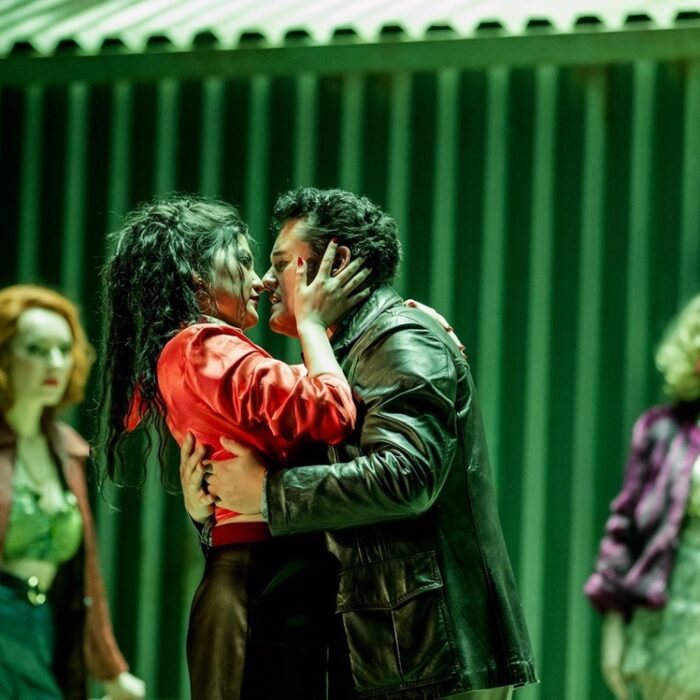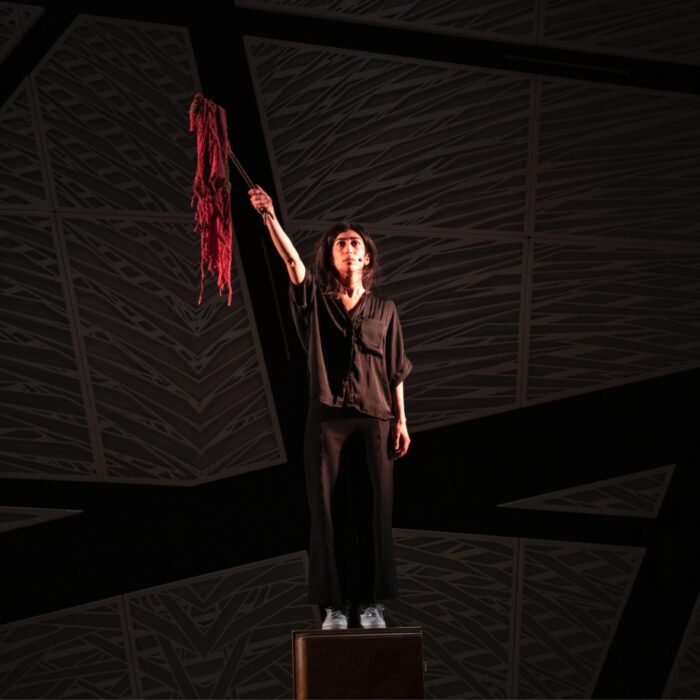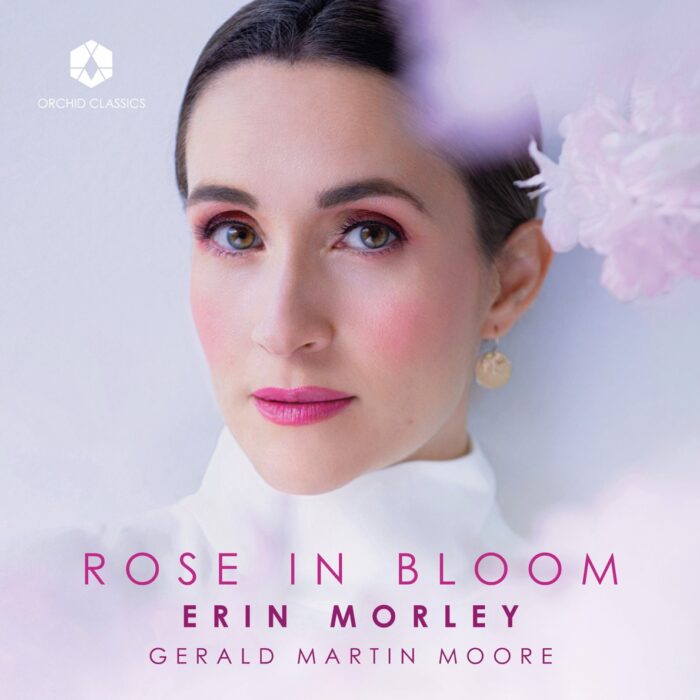
Teatro Comunale di Ferrara 2024 Review: Orlando Furioso
Mynenko Shines in an Inconsistent Production of Vivaldi’s Masterpiece
By Alan NeilsonPhoto credit: Marco Caselli Nirmal
Vivaldi’s “Orlando Furioso” is a work that represents baroque opera at its most exciting. Set on Alcina’s magical island, where the weird and wonderful are commonplace, it opens up the possibility for colorful and spectacular stagings with shipwrecks, fantastical beasts, monsters and statues that come to life. There are high mountains, wooded groves, steep cliffs and deep caverns from which escape is impossible. The sorceress Alcina rules over the island through the force of her magic, using her potions and spells to captivate and control those who find themselves in her enchanted realm. Grazio Braccioli’s libretto is imaginative, fast-moving and action-packed, and Vivaldi’s score is full of exciting and beautiful music, including an array of highly emotional arias that allow the singers to show off their skills. The dramatic center is a brilliant mad scene for Orlando, whose unreturned love for Angelica causes him to lose his reason.
In the hands of the right cast and production team, “Orland Furioso” can be a visual and aural feast that is able to transport the audience to a land of intrigue and fantasy.
A Visually Low Octane Production
Although the Teatro Comunale di Ferrara’s production failed to take full advantage of the work’s visual possibilities–there were no fabulous beasts or statues coming to life, and the magical elements rarely took on a physical form–it was nevertheless a tidy performance that promoted the narrative in a clear and imaginative manner.
The director, Marco Bellussi, shifted the primary focus away from Orlando and onto Alcina; she is the driving force behind the events! She is responsible for creating the myriad realities into which the characters are plunged as she pursues her desires. To this end, the scenographer, Matteo Paoletti Franzato, created a stage in which the walls and ceiling were often made of mirrors, so that reality became confused as the images were reflected back and forth upon each other. There was little in the way of props beyond the necessary stools, tables and a heap of presents for Angelica and Medoro’s wedding. It was all very simple, and it would have been visually fairly monotonous if it had not been for the frequent use of Fabio Massimo Iaquone’s video projections, which had the effect of taking the production to an aesthetically higher level.
Images of trees were frequently projected onto the sides and back wall of the stage to create a picture of the island’s wooded glades in which part of the narrative is set. At times, the green leaves wafted gently in a light summer breeze, but not always; there were storms; there was snow; the leaves even changed colors with the passing seasons. Given, however, that the drama takes place over the course of hours and not months, it played with the audience’s perceptions of time and of reality, adding to the sense of magic that pervaded Alcina’s island.
In what was an imaginative decision, significant parts of the texts were projected in bright white letters onto a transparent curtain across the front of the stage and onto a black colored frame that surrounded it, while the action continued uninterrupted. When Orlando descended into madness, his words swirled across the stage in jumbled and senseless forms. Iaquone also used rapidly twisting and turning white shapes to create fantastical patterns behind which Orlando appeared to be trapped. It was a strong and captivating image.
Elisa Cobello’s eclectic mix of costume designs ranged from Ruggiero’s red and black renaissance arrangement, Angelica’s early 19th century, long white dress to Alcina’s dark blue, early 20th century ballgown, which successfully added some necessary color to the staging.
Overall, the staging was fairly limited and fell short of expectations, although its high points were very well conceived and did enough to ensure that it held the audience’s attention.
Mynenko’s Standout Performance as Orlando
The assembled cast produced a pleasing, if somewhat uneven, presentation with one or two excellent performances, of which the countertenor Yuriy Mynenko stood out in the role of Orlando. Although his acting was a little understated, his vocal characterization of the paladin was compelling. Possessing an agile, controlled and colorfully interesting voice, he created a sensitively nuanced and intelligent portrait that captured the emotional extremes and arrogance of Orlando, and his second act “mad scene” was brilliantly executed. His phrasing was wonderfully detailed, containing subtle dynamic and emotional inflections, and he moved his voice with ease, taking in audacious leaps and spinning out florid embellishments, in what was a commanding and expressively strong performance.
Contralto Sonia Prina, in the role of Alcina, took control of the stage, and asserted her character’s ownership of the island; she was confident and dismissive to the point of absurdity, something that her big hair deliberately magnified. It was an amusing portrayal, and it worked well. Prina is a singer who is not afraid to take risks and is prepared to push herself to her limits in order to achieve expressive truth. It is something her recitatives, in particular, benefited from; they were delivered with emotional power that brought her interactions with the other characters wonderfully alive. Her renditions of her arias were less consistent, although her emotions were never in doubt. For her aria, “Vorresti amor da me?” she made it very clear that she had no intention of remaining faithful to Astolfo as she spat out her lines with contempt, verging on anger. Often, however, her arias had a less pleasing mechanical element in which her complex coloraturas were rendered with a heavy staccato.
Soprano Arianna Vendittelli did not make a particularly convincing start. Her first aria, “Un raggio di speme,” sounded a little heavy and lacked her normal bright vitality. Fortunately, she quickly got into her stride with a lively and vivacious reading of her aria “Tu sei degl’ occhi miei,” in which she showed off vocal agility and coloratura to excellent effect, while her rendition of “Chiara al pari di lucida stella,” one of Vivaldi’s most beautiful arias, was superb; her delicious phrasing, sensitivity to the text, slow, graceful coloratura, and the alluring quality of her voice created one of the finest moments of the evening.
Contralto Chiara Brunello impressed in the trouser role of Medoro. She strutted around and adopted postures that one would expect of a young, aggressive male. She was earnest and manly at all times. Her duet with Angelica, “Bella pianticelle,” was compelling; it was so sensitively staged that the illusion of a love match between a male and female was never broken. Brunello’s performance was energetic, committed and expressive throughout.
Playing the role of Bradamante, soprano Loriana Castellano, dressed in a red costume with red hair, immediately brought to mind a picture of the composer, although this was more than likely a coincidence. Her Bradamante was a very emotional character, whose love for Ruggiero she clearly displayed. However, although her singing was correct, on occasions she did not bring enough emphasis to the vocal line, and her singing sounded a little passive.
Countertenor Filippo Mineccia as the lovesick Ruggiero, who falls under Alcina’s spell and forgets about his lover Bradamante, produced a sensitive portrayal as a desperate character who is completely at the mercy of his passions, buffeted one way, then the other. His delivery of the text was clear and articulate, and his crafting of the vocal line was sensitively wrought, replete with beautiful embellishments that captured both the strength and nuance of his raging emotion.
Baritone Mauro Borgioni created an excellent impression in the role of Astolfo. He possesses an agile voice with a warm, welcoming timbre, which he used successfully to define his character. Recitatives were clearly and expressively delivered, and his arias displayed passion and beauty. He opened Act three with an exciting rendition of the aria “Dove il valor combatte,” in which he imbued his voice with heroic swagger that showed off the expressive quality of his voice to good effect.
Sardelli’s Musical Direction Fails to Reach His Usual High Standard
A new edition of the score by Federico Maria Sardelli and Alessandro Borin was used for the performance. Sardelli, who also acted as the musical director and can normally be relied upon when overseeing a performance of a Vivaldi opera, elicited an inconsistent performance from the Orchestra Barocca Accademia dello Spirito Santo. The first 30 minutes, especially, lacked drive; the sound was thin and pedestrian, even plodding at times, which communicated itself to the stage so that the drama also lacked the expected energy levels. Fortunately, it did improve significantly over the course of the evening, and the orchestral sound became more assertive; it attacked the line with greater confidence and played with more freedom and vitality.
At the final curtain, one felt satisfied. The performance had started quite slowly, with the orchestra and one or two of the singers taking time to get into their stride. At the end of Act one, the feeling was not wholly positive, although there were positives to be had. In Acts two and three, it gained the necessary momentum and whipped up the necessary tensions, both musically and dramatically, to convince.



